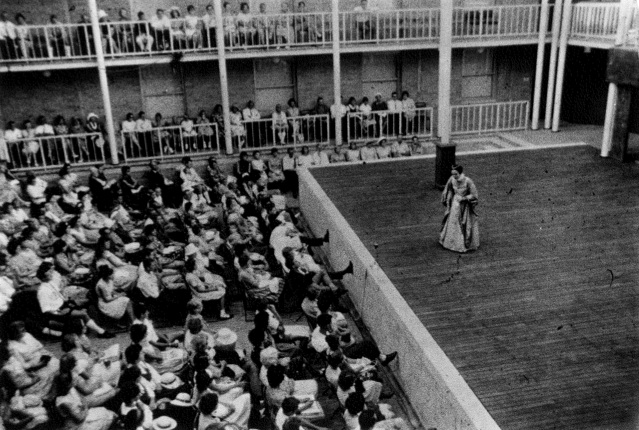The recent Pop Up Globe theatre at Crown Casino, Perth, is currently showing 16th century playwright William Shakespeare’s works, including Hamlet and A Midsummer Night’s Dream. As well as being a testament to the timelessness of his tales, the Pop Up Globe reminds me of UWA’s own homage to the Bard. Whilst seeking a shady shortcut on a sunny Perth day through the Arts Building, a display about a new garden incorporating the plants mentioned in Shakespeare’s plays caught my eye.
The first of its kind ‘Down Under’
Shakespeare gardens, which are gardens themed around plants mentioned in Shakespeare’s works, are common in North America; one of the most well-known is in New York’s Central Park. The one at UWA, however, is the first and only of its kind in Australia.
It all started with a review of the abandoned part of the courtyard in the Arts Building, and how it might be converted into a functional space. Professor Bob White, from the Australian Research Council’s (ARC) Centre of Excellence for the History of Emotions, proposed a Shakespeare garden.
Launched in 2018, the project was jointly-funded by the ARC Centre of Excellence for the History of Emotions, and the Faculty of Arts, Business, Law and Education. It was landscaped, and is now maintained, by the UWA grounds staff.
It started with a stage
The garden begins at the entrance of the New Fortune Theatre. For those still using the ‘Lost on Campus’ app like myself, this faces the lawn called the Great Southern Court, between the tropical grove and Reid Library.
The drama begins at the entrance, with two trees mentioned in Shakespeare’s works: a magnificent Cypress to the right, which represents death, and to the left, an Elm, symbolising sturdiness, protection, and strength.
The theatre itself was envisioned by Professor Allan Edwards, the Chair of English at UWA when the Arts Building was proposed after World War Two. Edwards just happened to know the stage dimensions of London’s Fortune Playhouse (where many of Shakespeare’s plays were performed), so when he discovered that the new building was going to have an inner courtyard, he convinced the architects to build a bridge of balconies across the middle. Once that had been agreed, he then proposed they also build a platform, confessing his desire that it would be used as a theatre.
Thanks to Professor Edwards, UWA now has the only permanent reconstruction and dedicated working replica stage of the Fortune Playhouse. Scholars from around the world visit UWA to see our unique replica; during the research for the rebuilding of the Globe Theatre, London (another location where Shakespeare’s plays are performed, and the same ‘Globe’ that the Perth Pop Up theatre is based on), the project founder, Sam Wanamaker CBE, came to UWA to view our replica.
Prideful Peacocks
Our majestic feathered friends, the peacocks – which symbolise pride – are both regular patrons of the garden, and frequently mentioned in Shakespeare’s works. The following is from one of my favourite plays, The Comedy of Errors:
Let frantic Talbot triumph for a while
And like a peacock sweep along his tail.
Curiously, the peacocks will sit upon the balconies surrounding the theatre to watch plays. I’m told on good authority that, similarly, whenever a bird or a peacock is mentioned in the play, , and or when there is a high-intensity moment, the peacocks ‘join in’ by crying out.
The Garden behind Juliet’s Balcony
The balcony directly behind the stage is known as Juliet’s Balcony, from one of the most famous scenes of all of Shakespeare’s works, in Romeo and Juliet. Pomegranates have been strategically grown under the balcony, as there are three references to pomegranates in this play. It has been thought that the tree in the Garden of Eden was not actually an apple tree, but a pomegranate tree, hence Shakespeare’s use of the fruit as a symbol of temptation.
Among The garden’s herbaceous references to Shakespearean works are roses, which, feature prominently both in the courtyard and Romeo and Juliet:
What’s in a name? That which we call a rose
By any other name would smell as sweet
During Shakespeare’s time, the Wars of the Roses (1455–1489) were civil wars fought over the throne of England. Red and white roses were symbolic of those conflicts, and were mentioned frequently in Shakespeare’s works. From Richard III:
And then, as we have ta’en the sacrament,
we will unite the White Rose and the Red
Smile heaven upon this fair conjunction,
That long have frown’d upon their enmity!
What traitor hears me, and says not Amen?
Similarly, the garden’s palms represent authority; they were carried in processions in front of Julius Caesar, whom Shakespeare also wrote a play about. The box hedges feature prominently in both this garden and in Much Ado About Nothing, incorporated in a scene where the characters eves-drop behind hedges.
I leave you with a parting thought, a small token by which to remember this garden – although you are welcome to use it at any time of day. Ophelia, in Hamlet, says of rosemary:
There’s rosemary, that’s for remembrance: pray, love, remember.
Further information about the collection of plants in the garden, and their use in Shakespeare’s works, is available on the display board at the entrance to the New Fortune Theatre. More information about the Theatre and upcoming performances can also be found on this display and notice board.
Special thanks to the founder of the garden, Professor Bob White, with his colleague Dr Kathryn Prince, for taking the time to show and explain this special space to me, and to Dr. Heather Bray for guidance on how to interpret a display in SCOM3319.
You can book tickets and find out more about the Pop Up Globe Theatre here.
Words by Tamara Pinkerton

